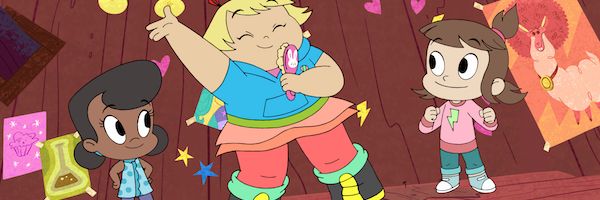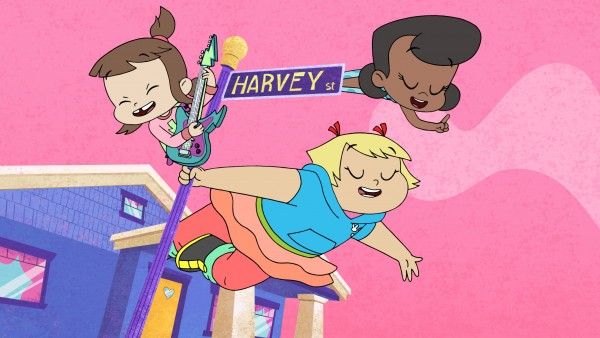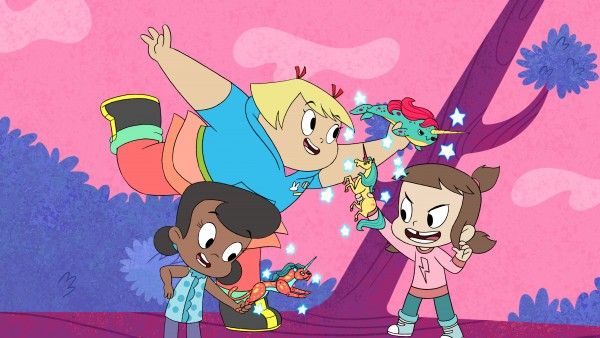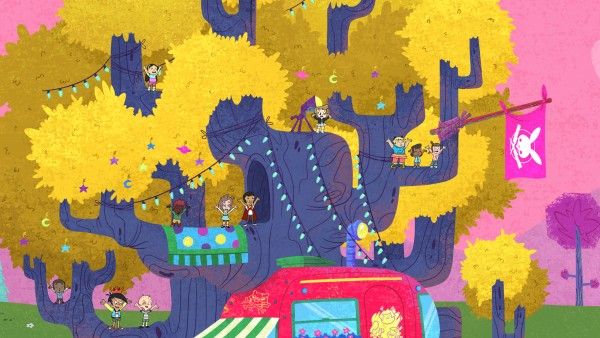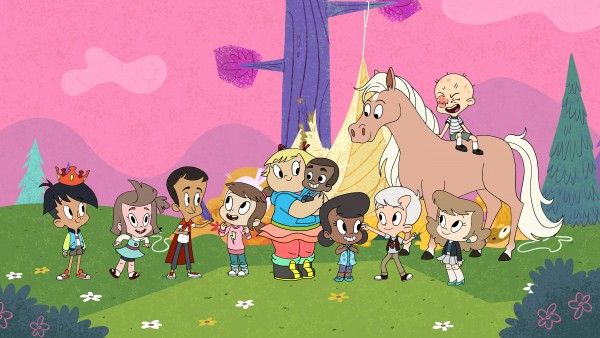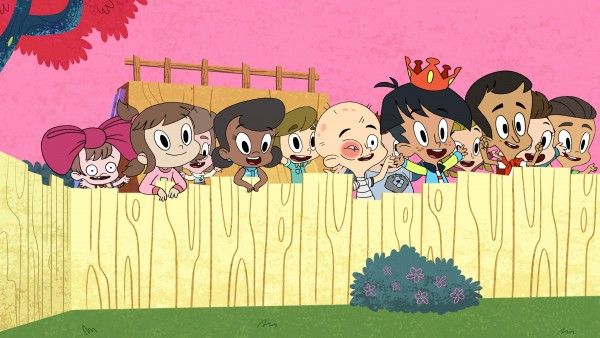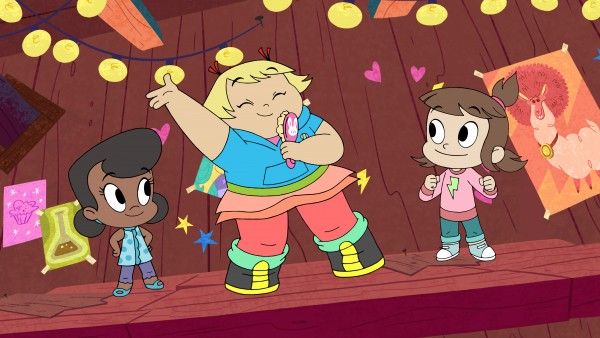Get ready for your new favorite summer block party obsession! DreamWorks Animation Television's new Netflix series Harvey Street Kids brings classic characters from Harvey Comics to life in the modern era. Audiences get to join Audrey, Dot, and Lotta as they get into all sorts of misadventures on their block from "school's out" to sundown, and sometimes even later. It's a fantastically fun new show that pays homage to both the iconic characters that have been around for decades as well as 80s and 90s classic cartoons like Ed, Edd n Eddy, Nicktoons fare, and The Powerpuff Girls. Harvey Street Kids might just be your new go-to source of animated neighborhood shenanigans! You can read my review here for more.
I had a chance to chat with Executive Producer Brendan Hay (Dawn of the Croods, Robot Chicken) and Supervising Producer Aliki Theofilopoulos (Descendants: Wicked World, Phineas and Ferb) about their process of adapting the characters and finding their core leads in Lauren Lapkus, Stephanie Lemelin, and Kelly McCreary. We also dug deep into the animation of this show and how they settled on the final look. And it might surprise you to find out, but Harvey Street Kids features an original Boy Band comprised of Joey McIntryre (New Kids on the Block), Nick Lachey (98 Degrees), Joey Fatone (*NSYNC) and Shawn Stockman (Boyz II Men), so of course we talked about how that all came together. But first!
Check out our exclusive clip to get a glimpse of Harvey Street Kids and a strong sense of the core cast of characters, followed by our interview:
What's a kid to do when it's raining and you can't play outside?! Let Lucretia show you the way. Hide inside when Harvey Street Kids comes to Netflix June 29!
For folks who might not be familiar with the Harvey Comics, what’s your one-sentence pitch for Harvey Street Kids?
Brendan Hay: Our story editor, Mike Yank, had my favorite summary of our show: “Kids live on a block.” Full stop. We are a wonderfully [high]–concept show, it really is. The more sincere one-sentence is, “This is the time of day in a kid’s life between being finished with school and not yet going home for dinner.” It’s about that part of childhood where it was just a kid society and the fun and shenanigans and all their experiences that happen in that time.
Why Harvey Comics and why the Harvey Girls in particular?
Brendan Hay: I think it’s two-fold: The very practical answer is, there’s an executive here at DreamWorks, Beth Cannon, and this was her passion project for a very long time. She was the one who brought these characters to Aliki’s and my attention. There had been another writer who she drew up some of the takes on it with, Emily Brundige. So it was a case of being already in flux once Aliki and I came in.
But, once we started playing with the characters, what really spoke for me about these Harvey Comics characters is, at their core, these are three really strong, really funny female characters. And it’s just nice to be able to take that and run with it. We try our best to honor the original core of the characters while also updating them for modern times. They just paired so well together, the three of them: Audrey, who’s almost feral in her 110% enthusiasm for everything, and Dot, who is so precise—in the comics, she’s obsessed with dots so we expanded it so that she’s obsessed with everything, be it science or fashion—and Lotta who, again, in the old comics, was defined by always eating things, but also she was the kind of wonderful, oversized personality in all fronts, from being super-strong to being super-cheery, so we just decided to embrace that she has a passion for everything. They’re three very specific types that lend themselves very well to comedy.
Aliki Theofilopoulos: For me, the draw was, when the studio first presented the project to me, I had worked on the Mickey shorts for a while, and particularly I had done the Minnie short, and I loved that we got to envisage these old sensibilities. Being a big cartoon fan, a true fan, that I really loved my experience of being able to visit a classic character in a new, modern way. So working with Harvey Comics characters felt like that to me. But on top of it, working 20 years in this industry, I really, really wanted to work on cartoony female characters that were three, distinctively different types of characters, that it wasn’t going to be a show where there was “The Girl One” where her “personality” was the girl character, but that there were three, completely different cartoony girl characters. That was something that I really wanted to do and felt like I hadn’t done before, so that was a great opportunity to have a chance to do that.
How difficult was it to bring the 1940s characters into the 21st century? How much freedom did you have in doing so?
Hay: Thankfully we had a lot of freedom. This was a case where we could kind of just get a sense of what we wanted to keep and then treat them as original characters, in a good way. Although it was always to not forget the roots—keep Audrey’s personality, keep all three of their underlying personalities—otherwise, they’re kids today. We wanted to make sure that anything that they were dealing with would be relatable and we wanted to increase the diversity of the cast and things like that. So not just the three core girls, but we also bring a lot of the support cast from the comics into the modern era also; most of our supporting cast has its roots in Harvey Comics. Similarly with them, we wanted to make them more diverse, but each one of those characters also retains the roots of why they were funny and interesting in the 40s, which thankfully is something that’s just kind of universal. The funniest one of all, to me, was Lucretia, who’s a supporting cast member, but even in her old appearances in the 40s and 50s she’s a fangirl. Even before the term existed, she was just the friend who was super-impressed with Little Audrey. It’s fun to know that there’s a universality and timelessness that exists to these characters, regardless. As long as we keep that, it really did feel like everything else would be what a kid show would be today with kids we’d want to put in it.
Theofilopoulos: The great thing about this show is that the characters are so clearly defined. I always say, you could pick up a script with all the names blacked out and you would know exactly who was saying each line. Because these characters were so defined and so clear, we could kind of give them any scenario or situation and let them run with it because it was just fun, a fun thing to push to the extreme. It was something that its roots began in a classic way, but we were able to take it and push it to this whole other level that was updated and more extreme.
Hay: It’s funny that you mentioned Ed, Edd ‘n’ Eddy and those other shows because we’ve been wanting to go back to the character-driven comedy of the late 80s, early 90s, which was like Hey Arnold! or Doug or, slightly different, but Pete and Pete. Going back even further, Peanuts is on that spectrum, too, and the original Harvey Comics. There’s this great tradition of character-based cartoony cartoons that hasn’t been done in a while; this is a chance to get to do that, and specifically do that from a female perspective.
Theofilopoulos: And I have to say that, on the art side, that became a part of the show aesthetically. We wanted to go back to more of a traditional style of animation in the sense that the characters are three-dimensional-ish, they’re squash-and-stretch-y, they’re traditional. I came from a traditional animation background so I really wanted to bring that into what we were doing, so there is a true nod to the history of cartoons.
How much of the storytelling was pulled from the comics themselves and how much was inspired by either your own childhood memories or by modern kids’ experiences?
Hay: A lot more of the latter. To my own knowledge, I think there’s only one spot that actually goes back to the original comics.
Theofilopoulos: Yeah, one or two, at most. The comics were really used more as a point of departure.
Hay: Exactly. But as for raiding our own childhoods, very much so. I think a lot of our stories have the nugget of embarrassment as a kid or the things that we wanted to do as a kid or something like that, and then it would be, “What if that was turned up to 11 for this tale?” We had one writer on staff, Jamie Uyeshiro, who really ended up inspiring a ton of the Audrey stories with her own family. She is basically the Audrey in her family, so there was some amazing stuff we got from her. We also have a collaborative crew, so like our board artist would identify with one of our supporting characters and might be like, “Here’s the gag that’s in here, but here’s a more specific version of it that goes back to my own childhood,” and we’d be like, “Yes, let’s put that in instead!” We tried to create a crew where, whoever you were from production assistant up through director, all could chime in with memories from their childhood and we tried to work things in as it helped.
Can you talk a little more about reaching the final decision on the look of Harvey Street Kids?
Theofilopoulos: Having been in this industry for 20 years and starting in a very traditional way, working at Disney feature animation and then moving into television, working from 2D to CG across the map, I always believe in letting the content tell you what style it needs to be animated in, and this one very much was screaming, “Traditional animation!” Starting from there, and looking at what kind of shapes would work well with 2D traditional animation, as far as the look and the color scheme, Peter Emmerich—our art director—and I, we looked back on a lot of the old Yogi Bear backgrounds; that was a huge inspiration for us and our shape language, even right down to the clouds. We just felt like there was enough of a stylistic imprint to feel like we would make a statement with our show but it would also capture that nostalgic feeling and lend itself to 2D animation.
But then we wanted to push it further with our color palette, and not just capture the feeling of being a girl, but we joked about “punk-rock pink” like how the skies are pink, but it wasn’t just, “Girls like pink!” but rather “in-your-face punk rock with volume” pink. And then also fit in with us wanting to capture what childhood felt like and reflect back how childhood felt, that maybe the skies would be pink in that kind of scenario. Those were some of the things that were in our conversations.
Let’s talk about the cast you assembled; it’s a combination of relative newcomers to the animation world and voice-acting veterans. How did this all come together?
Bay: Really, we went through a long process on the leads. We really tried out a lot of people. It had a little bit of development time before Aliki and I jumped in, but even before we did, it really was about trying to find almost kind of the human embodiment of the three girls. Thankfully, we did, through the whole process, finding Stephanie Lemelin, Kelly McCreary, and Lauren Lapkus. Thankfully I had worked with Stephanie before so that was a little bit of an easier one, knowing that she naturally also is an Audrey.
Theofilopoulos: Kelly is very much naturally Dot. She likes to correct our English. [laughs] She’s very particular, very smart.
Hay: And Lauren just has this wonderfully large heart and goofiness to her. She just embraces every ridiculous thing we threw at her as Lotta; never a doubt or a moment’s hesitation. The three girls were kind of a long process, but the rest of the cast was relatively easy. We pulled in a mix of very specific voices or talent that we knew from their on-camera work, or veteran voice cast who we’ve either worked with in the past or, similarly, we just knew the talent to be perfect for such and such a character. I just do my best in life to never work on a show without Grey Griffin. [laughs]
Theofilopoulos: And then we had amazing people show up as our guest cast.
Hay: Yeah, that was a lot of fun also. We had expanded our world and had more characters, and we got to have some fun stunt casting. The boy band thing was one of my dreams early on. I think Crush4U got written into the first episode?
Theofilopoulos: They very first episode! They talk about the band.
Hay: I threw it in as a joke like, “Man, that’d be really cool if we could run with it and make up a boy group that was like a supergroup of actual boy band members.”
Theofilopoulos: Lucky for us, actual boy band members were up for the task and we got to make our dreams come true and bring them into the show.
Hay: It was so much fun in those recording sessions and getting to see cool, pop music done by the pros. All of them were super funny and so game for everything, as well.
And just to say, going back to our core cast, a few of them are new to voice acting but were just really running with it. I can’t really speak highly enough about them. They all helped bring their characters to life so that we could, as the series goes on, do an episode solely about Fredo, or Pink Eye, or Melvin, or Tiny, or all of them, and that’s in large part thanks to our cast helping bring them to life.
One of the other nice things is we actually got to ensemble record, so a lot of our cast got to really become friends and record together a lot. Our core cast, our three leads, became friends in real life.
Theofilopoulos: It’s fun to see them posting on social media, going on little outings with each other.
Is there a chance we’ll see other Harvey properties like Casper or Richie Rich get a reboot? Maybe a crossover or cameo appearance?
Hay: Right now, nope.
What makes DreamWorks Animation and Netflix the perfect partners for a show like Harvey Street Kids?
Hay: After doing two series now with them, I really love the freedom and support DreamWorks offers its crews. We were allowed to really run with the characters and the stories we wanted to tell, and given the resources to try nearly every ridiculous idea we had. And you can't beat the reach of Netflix for getting a series out to the world right now.
Theofilopoulos: Ditto on the support aspect. We really felt that the studio was behind this show and our ideas. Our executive input was always additive and came from a place of trust. I've been really honored to be a part of such an incredible partnership, and see how that kinda of support and freedom impacted what we created. I'm so proud!
What do you hope viewers get out of Harvey Street Kids?
Hay: Our goal with Harvey Street Kids was to make a show that's not literally about childhood, but how childhood feels, so hopefully it should trigger fun memories for all.
Theofilopoulos: We want kids to see themselves and feel themselves in the show. We think our characters are so distinctive that if they don't see themselves, they'll perhaps see their friends and family represented on Harvey Street.
Hay: Oh, and laughs. Lots of laughs. We aimed for comedy that's smart enough for kids but dumb enough for adults.

